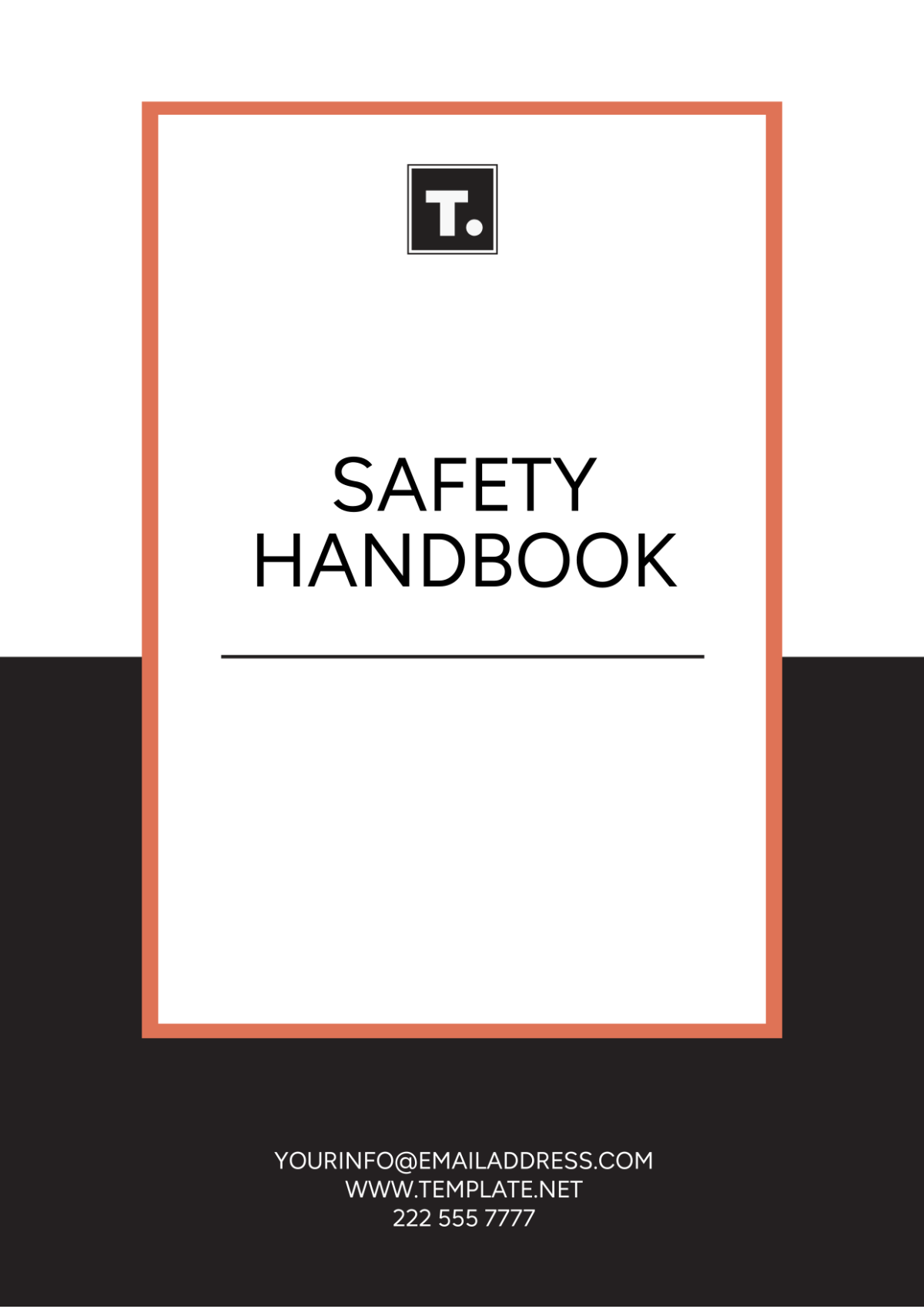Free Safety Handbook

This Safety Handbook is designed to outline essential safety practices and guidelines for employees of [YOUR COMPANY NAME]. Ensuring a safe work environment is a top priority for us, and adhering to these guidelines will help prevent workplace accidents and ensure the well-being of everyone.
This handbook is a go-to resource for all employees seeking information on the safety protocols at [YOUR COMPANY NAME].
I. General Safety Guidelines
A. Introduction to Workplace Safety
At [YOUR COMPANY NAME], we believe that every employee deserves a safe and secure work environment. This section provides an overview of the fundamental safety principles that each employee should follow.
Adherence to these guidelines is mandatory and any exceptions must be discussed with your supervisor. This is crucial to prevent injuries and ensure a safe working atmosphere.
B. Personal Safety Equipment
Personal Protective Equipment (PPE) is provided for the safety and health of our employees. Employees are required to wear PPE at specified times or when working in designated areas of our facilities.
Training on how to properly use this equipment will be provided and must be completed before commencing work. Incorrect usage of PPE not only compromises your safety but also that of your coworkers.
II. Emergency Procedures
A. Reporting Accidents and Incidents
It is critical that all accidents and safety incidents are reported immediately to the supervisory staff. This allows us to respond appropriately and also track incidents to prevent future occurrences.
Even minor incidents should be reported in order to ensure that all potential risks are documented and managed proactively.
B. Evacuation Procedures
In the event of an emergency requiring evacuation, all employees must follow the clearly marked routes to exit the building. Emergency exits and routes are marked throughout the building and are designed to be safely used in case of fire or other emergencies.
Regular drills are conducted to ensure that all employees are familiar with these procedures.
III. Health and Safety Regulations
A. Compliance with Laws
All employees at [YOUR COMPANY NAME] are required to comply with local, state, and federal safety laws and regulations. Training sessions and resources are available periodically to keep employees updated on new laws and amendments to existing regulations.
Not only does this compliance help prevent legal issues, it also contributes to a safer workplace.
B. Substance Abuse Policies
Our company maintains a strict no tolerance policy towards the use of drugs and alcohol within the workplace. Substance abuse compromises an individual's ability to perform tasks safely and can lead to serious workplace accidents.
Employees suspected of substance abuse will be subject to disciplinary action, up to and including termination of employment.
IV. Workplace Safety Practices
A. Equipment and Machinery Usage
All equipment and machinery must be used according to the operational manuals provided. Prior to using any machinery, an employee must complete training sessions and demonstrate an understanding of the safety procedures related to the equipment.
Regular maintenance checks are also mandatory to prevent malfunctions that could lead to accidents.
B. Housekeeping and Environmental Controls
Maintaining a clean and orderly work environment is essential for safety and efficiency. All areas should be kept free of clutter, and spills must be cleaned up immediately to prevent falls and injuries.
Proper disposal of waste materials and adherence to recycling protocols not only contributes to environmental conservation but also promotes a safer workplace.
V. Training and Development
A. Scheduled Safety Trainings
Regular safety training sessions are vital for new and existing employees. These trainings cover various aspects of workplace safety, including emergency response, equipment handling, and safe material storage practices.
Attendance is mandatory for all employees and must be recorded to ensure compliance and coverage.
B. Continuing Education
Employees are encouraged to pursue continuing education opportunities related to workplace safety. [YOUR COMPANY NAME] offers reimbursement for courses that contribute to an employee’s safety expertise.
Staying updated with the latest safety standards and practices is crucial for continual improvement of the workplace safety culture.
VI. Feedback and Continuous Improvement
A. Safety Audits
Periodic safety audits are conducted to identify potential risks and assess adherence to safety protocols. Feedback from these audits will be used to improve safety standards across the company.
Employees are encouraged to cooperate fully during audits and to contribute suggestions for improvement.
B. Employee Feedback Mechanism
We value the feedback from our employees regarding our safety practices. A suggestion box and regular surveys are available for employees to provide anonymous feedback.
This feedback is crucial for us to make necessary adjustments and improvements in our safety guidelines.
VII. Acknowledgment
By acknowledging receipt of this Safety Handbook, you commit to adhering to the safety guidelines and procedures outlined herein. This acknowledgement must be signed and returned to the HR department within [Business Days] of receipt.
Revision History
Date | Version | Changes | Approved By |
|---|---|---|---|
[Date] | 1.0 | Initial release of the Safety Handbook. | [YOUR NAME] |
- 100% Customizable, free editor
- Access 1 Million+ Templates, photo’s & graphics
- Download or share as a template
- Click and replace photos, graphics, text, backgrounds
- Resize, crop, AI write & more
- Access advanced editor
Ensure a safe and secure workplace with the Safety Handbook Template from Template.net. This customizable, downloadable, and printable template covers essential safety guidelines and procedures. With editable features in our AI Editor Tool, tailor the handbook to your organization's specific needs. Prioritize safety and compliance effortlessly with this comprehensive template.





























